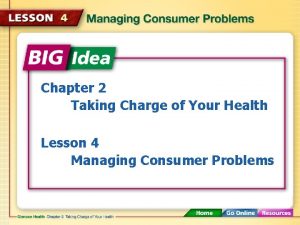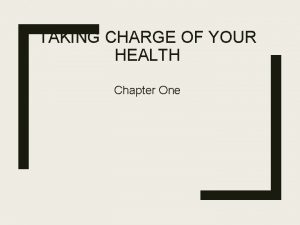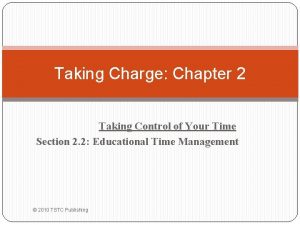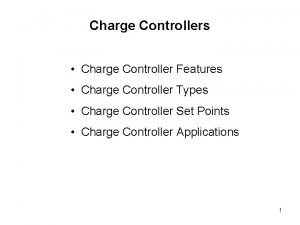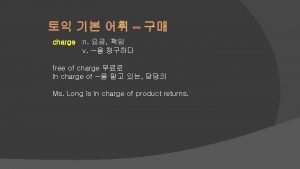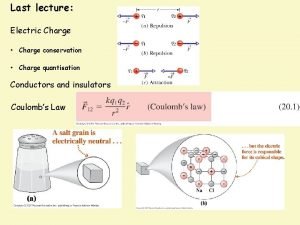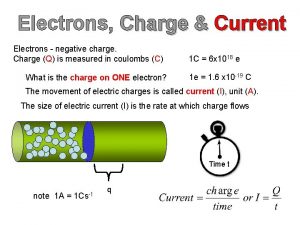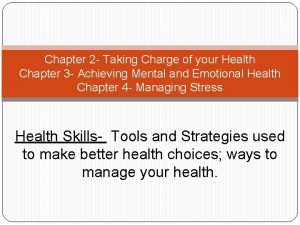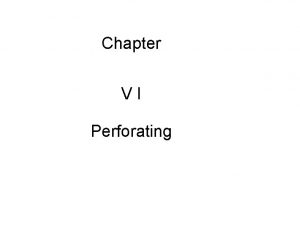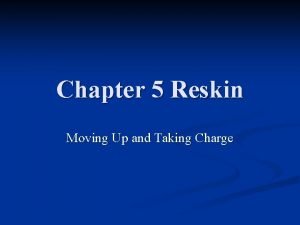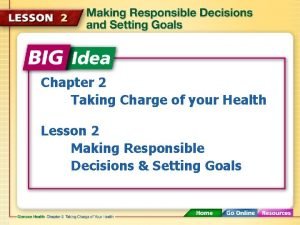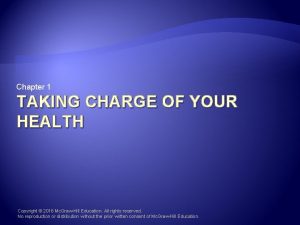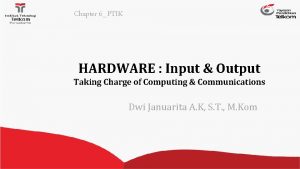CHAPTER 6 Taking Charge Chapter Overview Taking Charge





























- Slides: 29

CHAPTER 6 Taking Charge

Chapter Overview Taking Charge Decisions and Personal Growth n. Identifying the Basic Decisions in Your Life n. Making New Decisions n. Some Practical Applications Mastery and Personal Control • Perceived Control • Consequences of Perceived Control • Misperception and Maladjustment • Learned Optimism Personal Resolve and Decision Making n. The Process of Decision making n. Making Better Decisions

Chapter Summary Mastery and Personal Control • • Perceived Control Consequences of Perceived Control Misperception and Maladjustment Learned Optimism

Chapter Summary cont’d Personal Resolve and Decision Making • The Process of Decision Making • Making Better Decisions

Chapter Summary cont’d Decisions and Personal Growth • Identifying the Basic Decisions in Your Life • Making New Decisions • Some Practical Applications

Mastery and Personal Control Introduction Personal control-the achieved amount of control we have over our lives; this term is often synonymous with perceived control. • …an important issue in modern life! • We like to believe we have it, BUT various factors (e. g. , increased governmental involvement in our lives, unpredictable events such as terrorism or natural disasters), take control out of our hands!

Perceived Control • …an important aspect of personal control. • The belief that we can influence events in our environment that affect our lives. • …is intricately related to locus of control-the source from which an individual believes control over life events originates. • There are two perceived loci of control: – Internal –within the person (e. g. personality traits) – External – outside of the person (e. g. fate or the situation)

Perceived Control cont’d • Internalized control is very “American”; we prefer to think we are independent of others’ influences. • Citizens of other countries allow for some interdependence (e. g. Japan). • Gender differences? Men strongly prefer internal control; women are more tolerant of external control. People in developing countries perceive more external control than do members of industrialized countries (Ross & Mirowsky, 2002).

Perceived Control cont’d Researchers distinguish between: • Primary control--actions directed at attempting to change the world to fit one’s own needs and desires. • Secondary control--involves the individual utilizing processes directed at making him- or herself fit into the world better. • Cultural differences? Western – primary; Asian – secondary • Older individuals often use secondary…

Perceived Control cont’d Optimal adjustment –the amount of actual control matches the desired need for control. • Individuals high in external control can learn to develop a sense of internal control when beneficial. How much and what type of control are you comfortable with?

Consequences of Perceived Control • Research has also shown that the presence or absence of personal control/self-mastery has important consequences. • When we believe we can affect outcomes…we behave in significantly different ways than when we perceive no control. • Perceived control motivates us. Lack of perceived control can lead to apathy or depression.

Consequences of Perceived Control cont’d People high and low in perceived control differ. People high in perceived control: • Are more likely to seek relevant information when making difficult decisions. • Attribute positive experiences to their efforts, and abilities, rather than fate. • Resist the influence of others and rely more on their own feelings, attitudes, and values. • Are more achievement-oriented and motivated.

Consequences of Perceived Control cont’d • In Western societies, there is a strong correlation between perceived control (or self -mastery) and personal adjustment; those higher in perceived control are better adjusted. • Those high in perceived control are less anxious, less prone to mental disorders. • They also cope with distressing situations more effectively, and… • … take effective steps to maintain good health (i. e. , engaging in exercise, eating healthy).

Misperceptions and Maladjustment Some people believe they have: • more control than they really have, setting themselves disappointment. • little or no control when they really do. • People who expect excessive control may take risks and injure themselves; people who believe they have no control may expect injuries no matter what. • In both cases, extreme misperception can lead to maladjustment.

Misperceptions and Maladjustment cont’d • Among people who think they have more control than they have, risk-taking is common. • They engage in more activities where chance is the real determinant (e. g. lotteries). • Familiarity with/past successes in a situation only exaggerate their illusion.

Misperceptions and Maladjustment cont’d The other extreme--individuals who believe they have no control over their lives. They may suffer from: Learned helplessness-a maladjustment passivity that frequently follows an individual’s experience with uncontrollable events. • …it is associated with depression, academic failure, bureaucratic apathy, and even premature death.

Learned Optimism • …may be a useful means for achieving optimal but realistic self control. Learned optimism-A learned way of explaining both good and bad events, with our parents as our very first teachers. • It enhances our perceived control and adaptive responses to situations. • Seligman (1992), suggests that it is not life events but rather our perceptions of and reactions to them that most affect our lives.

Learned Optimism cont’d • Optimism and pessimism are learned styles of responding to life events. Three factors that contribute these explanatory styles: Permanence – how long will the event last? Pervasiveness – how much does it affect me? Personalization – how much at fault am I?

Learned Optimism cont’d An example: A friend, Lisa, didn’t call. An optimist would say: • “She must be busy today. ” (NOT permanent) • “This doesn’t make or break my day. ” (NOT pervasive) • “She likes me; she’s just working hard. ” (NOT personalized)

Learned Optimism cont’d Pessimist would imagine a different scenario: “She never returns my calls. ” (permanent) “Now my whole day is ruined. ” (pervasive) “She is probably avoiding me. ” (personalized)

Learned Optimism cont’d • …despite optimism, personal responsibility DOES play a role in many life events. • If you deliberately do something foolish and fail, you should admit responsibility and learn from it. (And apologize, too!) An optimistic style is best in situations that: that • Involve achievement • Otherwise would create stress • Require leading others

Learned Optimism cont’d An optimistic style is NOT appropriate in situations that require: require • Talking with others whose future is dim • Reacting with sympathy for others • Taking risks • Planning exact details to avoid failure The basic guideline for choosing optimism: optimism Ask what the cost of failure is in the situation. When the cost is high, optimism may be the wrong strategy. For example, driving home drunk from a party in hopes that you will not be caught is an unnecessarily risky and foolishly optimistic behavior.

Personal Resolve and Decision Making-The process of gathering information about relevant alternatives and making an appropriate choice. The Process of Decision Making The recommended steps: • Rising to the challenge • Searching for possible alternatives • Evaluating each alternative • Making a commitment • Assessing your decision

The Process of Decision Making cont’d • Fatigue, haste, poor advice, and other factors can lead to poor decisions. • Postdecisional regret is is normal especially after particularly difficult decisions. • Another term for this is cognitive dissonance--an uncomfortable cognitive feeling (of regret). • Cognitive dissonance eventually goes away.

Making Better Decisions Good decision? Bad decision? This can only be determined by you! To improve decision making: making • Try to use sound judgment and common sense • Draw up a balance sheet of pros and cons • Clarify your own values and objectives • Expect reasonable, not perfect, results • Make the best of a poor decision; learn from it

Decisions and Personal Growth A border patrol canine sniffs for hidden drugs. Hiding drugs in cars that cross the borders is foolhardy. Identifying the Basic Decisions in Your Life • Many negative behaviors are the result of decision making–deliberate or not – start with these first. • Do not become a victim of your own rebelliousness and poor-quality decisions. • Once a decision is made we often organize our lives, our perceptions, and other decisions around it.

Making New Decisions • Humanistic psychologists: “People do not actively decide, change, and grow. ” • …only when we really wish to change are we led to actual decisions that produce change. This signals personal growth. • We can only change ourselves; we cannot force another person to decide, to change, or to grow.

Making New Decisions cont’d Therapists, friends, teachers, and significant others should not tell others that they need to, how to, or what they ought to change. • These well-intentioned people make the same mistakes parents make with their children, (e. g. , “I’ll ONLY love you IF …”). • People can and do change on their own upon selfdiscovery or because of personal pain. • The best advice to offer? Follow the steps in sound decision-making!

Some Practical Applications • Deciding not to decide is a decision, but may not be a good one! • The same goes for putting off a decision! • Reversing or amending a past decision might be wise, even at the risk of embarrassment. • Failing to take a few reasonable risks while making decisions limits our opportunities for growth. • Seeking thoughtful advice from others can be a good thing. Occasionally, two heads are indeed better than one.
 Chapter 2 taking charge of your health
Chapter 2 taking charge of your health Taking charge of your health chapter 2
Taking charge of your health chapter 2 Taking charge of your health chapter 1
Taking charge of your health chapter 1 Taking charge destiny 2
Taking charge destiny 2 Senge learning disabilities
Senge learning disabilities Difference between charge and electric charge
Difference between charge and electric charge Difference between static and current electricity
Difference between static and current electricity Emt chapter 24 trauma overview
Emt chapter 24 trauma overview Emt chapter 14 medical overview
Emt chapter 14 medical overview Chapter 9 lesson 2 photosynthesis an overview
Chapter 9 lesson 2 photosynthesis an overview Chapter 12 selling overview
Chapter 12 selling overview Financial intermediaries
Financial intermediaries Chapter 1 overview of verb tenses
Chapter 1 overview of verb tenses Overview of personal finance chapter 1
Overview of personal finance chapter 1 Distoclusion definition
Distoclusion definition Chapter 1 overview of personal finance answers
Chapter 1 overview of personal finance answers Chapter 32 an overview of animal diversity
Chapter 32 an overview of animal diversity Chapter 1 an overview of financial management
Chapter 1 an overview of financial management Chapter 17 overview elements and their properties
Chapter 17 overview elements and their properties Chapter 1 overview of financial statement analysis
Chapter 1 overview of financial statement analysis Segregation images
Segregation images Rolling the dice and taking chances chapter 1 lesson 3
Rolling the dice and taking chances chapter 1 lesson 3 Www stands for world wide web
Www stands for world wide web Maximo work order priority
Maximo work order priority Universal modeling language
Universal modeling language Uml overview
Uml overview Retail vertical
Retail vertical Figure 12-1 provides an overview of the lymphatic vessels
Figure 12-1 provides an overview of the lymphatic vessels Overview of the major systemic arteries
Overview of the major systemic arteries Texas recapture districts
Texas recapture districts

